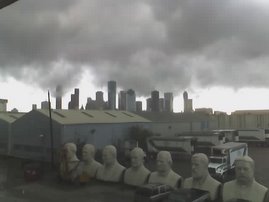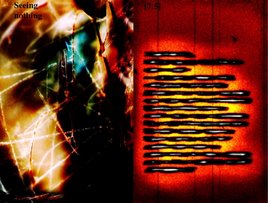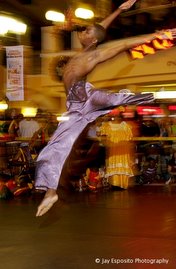Just in from seeing the Moscow Ballet! Oooh, it was lovely! Wonderful music, sublime dancing, gorgeous costumes, beautiful women and (best of all?) a Corp de Ballet bursting with strapping young men in tights! Bozhe moi!
*fans herself *
Anywho, to business.
Contacted the Tate today to request copyright permission to use thumbnails of paintings for us to discuss on the art post. They said yes…for a fee. So I very politely told them where to stick it. I’m really hacked off about this.
B*ll*cks anyway!
David G,
I’m still working on my list of favourite films (it’s sooo hard!) but I’ve been doing my homework and have read up a bit on Andrew Sarris and mise-en-scene, which I now know is [clears throat] “…(an) emphasis on the content of a frame rather than the relationship of one frame to the next..”
This is eye-opening to say the least. I’ve been labouring under the misguided belief that mise-en-scene is something MUCH more specific – a layering effect I’ve seen in some films.
For example, Buster Keaton’s Sherlock Jnr. (1924), where Buster literally steps INSIDE the film (how very Post-Modern of him!): The view of the cinema screen (the film inside the film) is framed by the stage. Buster steps off the stage into the screen, and then, through an opening door (apparently existing only in the two-dimensional space of the film), we see an interior space beyond (which is actually three-dimensional space).
Buster is playing with our minds and with our perceptions of spatial depth, blurring the lines between reality and fantasy! It’s very cool!
“In the character of a dozing film projectionist, Buster steps out of his sleeping body as his dream self makes its way through the aisle of the darkened theatre and steps up into the screen. Barely 20 years into the existence of the cinematic medium, Keaton was painstakingly examining the form’s limitations whilst at the same time exploding its possibilities. In questioning the artifice of presenting depth on a flat screen, Keaton simultaneously pushes the very limits to which that artifice can be made to seem wholly real. The illusion remains utterly convincing.” Thom Robinson. © 2006 University of Sheffield.
As the late, great Walter Kerr said, "He was the most silent, as well as the most cinematic, of silent screen comedians."
Sarris sees mise-en-scene as encompassing ALL aspects of visual style though (right David?), including “mystical meanings and [the] emotional tone” of the film.
I especially liked the definition that as opposed to the montage of, say, Eisenstein, mise-en-scene is the single shot, the “…static unblinking camera..”
The metaphysical “blink” of de Chirico’s “The Child’s Brain” (1914) always makes me think of Buster Keaton’s oh-so-expressive eyes – and his obliterating “blink”.
Sorry, now I AM being pretentious!
Still, I’ve always thought of Keaton as the master of the long shot.
Axasha D’Arc
Subscribe to:
Post Comments (Atom)









3 comments:
Axasha, this was, how can I say it, very enlightening. I have never thought of the old black and white silent movie as anything but, an old black and white silent movie, and yet the way you put it across makes me think about Keaton as an artist rather than just a funny man.
I did not think you were pretentious at all, and you make me think how static I have been since university. Maybe I have to get my head into things again.
Yes I have an interest in photography, but you are really enthusiastic.
I remember being like that once, long time ago, when I enthused over Mary Shelley and Byron's Don Juan, and that whole Gothic set.
Shame about the Tate, but don't worry you tried at least.
I have decided to try and get some stuff on Byron, Don Juan or Childe Harold. Haven't looked at that great and wonderful stuff since uni.
I hear you EL – and I completely agree!
In the mmfurmph years since I was at uni I’ve had little opportunity to engage in this kind of artistic discussion and, like you, I find that I miss it!
Look forward to reading a Byron critique from you!
Axasha.
Post a Comment